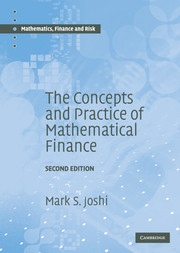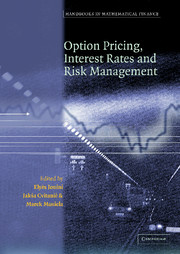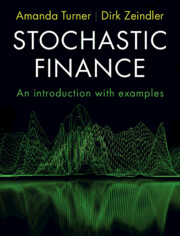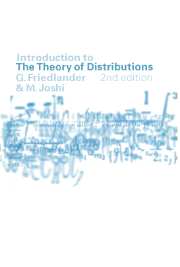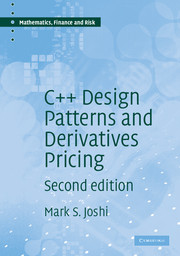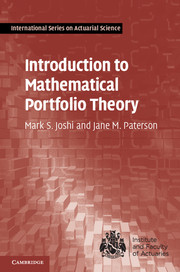The Concepts and Practice of Mathematical Finance
2nd Edition
Part of Mathematics, Finance and Risk
- Author: Mark S. Joshi, University of Melbourne
- Date Published: October 2008
- availability: Available
- format: Hardback
- isbn: 9780521514088
Hardback
Looking for an inspection copy?
Please email [email protected] to enquire about an inspection copy of this book
-
An ideal introduction for those starting out as practitioners of mathematical finance, this book provides a clear understanding of the intuition behind derivatives pricing, how models are implemented, and how they are used and adapted in practice. Strengths and weaknesses of different models, e.g. Black–Scholes, stochastic volatility, jump-diffusion and variance gamma, are examined. Both the theory and the implementation of the industry-standard LIBOR market model are considered in detail. Each pricing problem is approached using multiple techniques including the well-known PDE and martingale approaches. This second edition contains many more worked examples and over 200 exercises with detailed solutions. Extensive appendices provide a guide to jargon, a recap of the elements of probability theory, and a collection of computer projects. The author brings to this book a blend of practical experience and rigorous mathematical background and supplies here the working knowledge needed to become a good quantitative analyst.
Read more- Covers both martingale and PDE approaches to the subject and discusses multiple approaches to each problem
- Spends a lot of time on the underlying ideas and intuition behind the models; includes computer projects
- Covers alternative models such as stochastic volatility, jump diffusion and variance gamma as well as the conventional Black–Scholes
Reviews & endorsements
'The book is intended as an introduction for a numerate person to the discipline of mathematical finance. In this, Mark Joshi succeeds admirably - an excellent starting point for a numerate person in the field of mathematical finance.' Risk Magazine
See more reviews' … ideal for those who want to learn or deepen their knowledge about Quantitative Finance … The breadth of the book particularly impressed me. It went from theoretical to practical, while covering implementation-related issues. It makes concepts such as Martingales, Measures and Numéraires look so natural and easy. Pricing Quantos or Spread-Options becomes an innate result of these concepts.' Wilmott Magzine
The author allows the reader as often as possible to get an intuition for the models and concepts. Helpful information is given on how to use and implement these models and concepts in practical terms. This practice-orientation makes this book different from others belonging to this category … the text is also well suited as a textbook for a quantitative-oriented introductory course on finance at universities or other academic institutions … one can say that this introductory book in offering a well balanced and up-to-date introduction to the theory and practice of mathematical finance overshadows many other books available on the same subject.' Zentralblatt MATH
'The book has been very nicely produced by Cambridge University Press. I would certainly recommend that anyone teaching an introductory or intermediate course on this topic seriously consider this book as a potential course text.' International Statistical Institute
'Very few books provide a balance between financial theory and practice. This book is one of the few that strikes that balance … certainly a good addition to your collection of financial mathematics books.' SIAM Review
'The set-up of this book certainly meets the needs of the audience for whom this book is written. Moreover, the author brings the material in a very comprehensive way leading to new or better insights in several aspects of the material. An innovation is that besides worked out examples and exercises, a list of computer projects are included which encourage the reader to implement the models. This certainly adds to the learning process.' Kwantitatieve Methoden
Customer reviews
Not yet reviewed
Be the first to review
Review was not posted due to profanity
×Product details
- Edition: 2nd Edition
- Date Published: October 2008
- format: Hardback
- isbn: 9780521514088
- length: 558 pages
- dimensions: 249 x 170 x 30 mm
- weight: 1.22kg
- contains: 202 exercises
- availability: Available
Table of Contents
Preface
Acknowledgements
1. Risk
2. Pricing methodologies and arbitrage
3. Trees and option pricing
4. Practicalities
5. The Ito calculus
6. Risk neutrality and martingale measures
7. The practical pricing of a European option
8. Continuous barrier options
9. Multi-look exotic options
10. Static replication
11. Multiple sources of risk
12. Options with early exercise features
13. Interest rate derivatives
14. The pricing of exotic interest rate derivatives
15. Incomplete markets and jump-diffusion processes
16. Stochastic volatility
17. Variance gamma models
18. Smile dynamics and the pricing of exotic options
Appendix A. Financial and mathematical jargon
Appendix B. Computer projects
Appendix C. Elements of probability theory
Appendix D. Hints and answers to exercises
Bibliography
Index.-
Find resources associated with this title
Type Name Unlocked * Format Size Showing of
This title is supported by one or more locked resources. Access to locked resources is granted exclusively by Cambridge University Press to lecturers whose faculty status has been verified. To gain access to locked resources, lecturers should sign in to or register for a Cambridge user account.
Please use locked resources responsibly and exercise your professional discretion when choosing how you share these materials with your students. Other lecturers may wish to use locked resources for assessment purposes and their usefulness is undermined when the source files (for example, solution manuals or test banks) are shared online or via social networks.
Supplementary resources are subject to copyright. Lecturers are permitted to view, print or download these resources for use in their teaching, but may not change them or use them for commercial gain.
If you are having problems accessing these resources please contact [email protected].
Instructors have used or reviewed this title for the following courses
- Actuarial/Financial Mathematics
- Applications of the Heat Equation to Finance
- Applied Mathematics in Finance
- Computation Simul in Financial Math
- Data Driven Science
- Derivative Markets
- Math. & Stochastic Foundations for Finance
- Mathematical Economics
- Mathematical Finance A
- Mathematics and Finance; Modeling in Finance
- Mathematics of Finance
- Topics in Computational Science
- Topics in Mathematics: Mathematical Finance
- econophysics
- introduction to quantitative methods in finance
Sorry, this resource is locked
Please register or sign in to request access. If you are having problems accessing these resources please email [email protected]
Register Sign in» Proceed
You are now leaving the Cambridge University Press website. Your eBook purchase and download will be completed by our partner www.ebooks.com. Please see the permission section of the www.ebooks.com catalogue page for details of the print & copy limits on our eBooks.
Continue ×Are you sure you want to delete your account?
This cannot be undone.
Thank you for your feedback which will help us improve our service.
If you requested a response, we will make sure to get back to you shortly.
×
